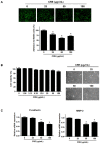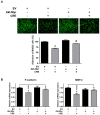The Anti-Endometriotic Effect of Cyperi Rhizoma Extract, Inhibiting Cell Adhesion and the Expression of Pain-Related Factors through Akt and NF-kB Pathways
- PMID: 35334511
- PMCID: PMC8953559
- DOI: 10.3390/medicina58030335
The Anti-Endometriotic Effect of Cyperi Rhizoma Extract, Inhibiting Cell Adhesion and the Expression of Pain-Related Factors through Akt and NF-kB Pathways
Abstract
Rhizomes of Cyperus rotundus have been widely used as a traditional medicine in Asia for the treatment of gynecological diseases. However, there is no scientific evidence demonstrating the effect of C. rotundus rhizomes on endometriosis, which is characterized by the adhesion of endometrial tissues outside the uterus, resulting in chronic and severe pelvic pain. The aim of this study was to investigate the effects of Cyperi rhizoma extract (CRE) on cell adhesion and the expression of pain-related factors (neurotrophins) in endometriotic cells, and to elucidate the underlying molecular mechanisms. CRE inhibited the adhesion of human endometriotic 12Z cells to peritoneal mesothelial Met5A cells using by adhesion assays. The mRNA expression of adhesion molecules [P-cadherin and matrix metalloproteinase (MMP)-2] was downregulated by CRE treatment. In addition, CRE significantly inhibited the mRNA expression of neurotrophins (BDNF, NGF, NT-3 and NT-4/5) in 12Z cells. Moreover, Akt overexpression markedly neutralized the inhibition of cell adhesion by CRE and expression of neurotrophins in 12Z cells. Furthermore, it was found that CRE suppressed NF-kB activation through the Akt pathway. These data suggest that CRE exerts anti-endometriotic activities by the inhibition of cell adhesion and neurotrophin expression, through the negative regulation of the Akt and NF-kB pathways in endometriotic cells.
Keywords: Akt; Cyperi rhizome; NF-kB; adhesion; endometriosis; neurotrophins.
Conflict of interest statement
The authors have declared no conflict of interest.
Figures






Similar articles
-
Costunolide induces apoptosis in human endometriotic cells through inhibition of the prosurvival Akt and nuclear factor kappa B signaling pathway.Biol Pharm Bull. 2011;34(4):580-5. doi: 10.1248/bpb.34.580. Biol Pharm Bull. 2011. PMID: 21467650
-
Protective effect of Cyperi rhizoma against 6-hydroxydopamine-induced neuronal damage.J Med Food. 2010 Jun;13(3):564-71. doi: 10.1089/jmf.2009.1252. J Med Food. 2010. PMID: 20521982
-
Anti-Endometriotic Effects of Pueraria Flower Extract in Human Endometriotic Cells and Mice.Nutrients. 2017 Feb 28;9(3):212. doi: 10.3390/nu9030212. Nutrients. 2017. PMID: 28264481 Free PMC article.
-
The association study of chemical compositions and their pharmacological effects of Cyperi Rhizoma (Xiangfu), a potential traditional Chinese medicine for treating depression.J Ethnopharmacol. 2022 Apr 6;287:114962. doi: 10.1016/j.jep.2021.114962. Epub 2021 Dec 28. J Ethnopharmacol. 2022. PMID: 34968659 Review.
-
Insights into iron and nuclear factor-kappa B (NF-kappaB) involvement in chronic inflammatory processes in peritoneal endometriosis.Histol Histopathol. 2011 Aug;26(8):1083-92. doi: 10.14670/HH-26.1083. Histol Histopathol. 2011. PMID: 21692040 Review.
Cited by
-
An Update on the Multifaceted Role of NF-kappaB in Endometriosis.Int J Biol Sci. 2022 Jul 4;18(11):4400-4413. doi: 10.7150/ijbs.72707. eCollection 2022. Int J Biol Sci. 2022. PMID: 35864971 Free PMC article. Review.
-
Systematic review of ethnomedicine, phytochemistry, and pharmacology of Cyperi Rhizoma.Front Pharmacol. 2022 Oct 7;13:965902. doi: 10.3389/fphar.2022.965902. eCollection 2022. Front Pharmacol. 2022. PMID: 36278199 Free PMC article. Review.
-
Therapeutic Potential of Natural Resources Against Endometriosis: Current Advances and Future Perspectives.Drug Des Devel Ther. 2024 Aug 21;18:3667-3696. doi: 10.2147/DDDT.S464910. eCollection 2024. Drug Des Devel Ther. 2024. PMID: 39188919 Free PMC article. Review.
-
An Overview of Bioactive Compounds' Role in Modulating the Nrf2/Keap1/NF-κB Pathway to Alleviate Lipopolysaccharide-Induced Endometritis.Int J Mol Sci. 2024 Sep 25;25(19):10319. doi: 10.3390/ijms251910319. Int J Mol Sci. 2024. PMID: 39408650 Free PMC article. Review.
References
MeSH terms
Substances
Grants and funding
LinkOut - more resources
Full Text Sources
Medical
Research Materials
Miscellaneous

